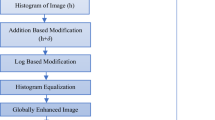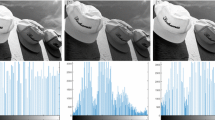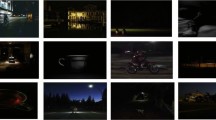Abstract
Low contrast image is one of the major challenges in photography. The low contrast image not only poses difficulty to the interpretation of the scene but also causes trouble in the onward processing of the image for computer vision tasks. Histogram equalization (HE) is a traditional and widely used approach for contrast enhancement and applies to almost all types of images. However, HE causes over-enhancement of the image which degrades its natural appearance. In this paper, a novel scheme for enhancing the image contrast while retaining its naturalness has been proposed. The proposed method uses the compensated histogram equalization technique on each channel individually followed by blending of the channels with a suitable adaptive brightness adjustment kernel. The three color channels are combined to form the intermediate image. The high-frequency noise introduced during the process is filtered out. Finally, adaptive power law transformation is applied to adjust the overall brightness and to retain its naturalness. This makes the method strong in terms of contrast enhancement along with details preservation. The proposed method is applicable to all the contrast degraded images as it automatically adjusts its parameters based on the degradation level. The simulation results, on the CSIQ dataset, show that the proposed method performs better, qualitatively, and quantitatively than the existing methods.













Similar content being viewed by others
References
Bhandari, A.K., Kandhway, P., Maurya, S.: Salp swarm algorithm based optimally weighted histogram framework for image enhancement. IEEE Trans. Instrum. Meas. 69(9), 6807–6815 (2020)
Qu, Z., Huang, X., Liu, L.: An improved algorithm of multi-exposure image fusion by detail enhancement. Multimed. Syst. 1–12 (2020)
Liu, J., Ge, J., Xue, Y., He, W., Sun, Q., Li, S.: Multi-scale skip-connection network for image super-resolution. Multimed. Syst. 1–16 (2020)
Meng, H., Yan, Y., Cai, C., Qiao, R., Wang, F.: A hybrid algorithm for underwater image restoration based on color correction and image sharpening. Multimed. Syst. 1–11 (2020)
Srinivas, K., Bhandari, A.K., Singh, A.: Low-contrast image enhancement using spatial contextual similarity histogram computation and color reconstruction. J. Franklin Inst. 357(18), 13941–13963 (2020)
Gonzalez, R.C., Woods, R.E.: Digital Image Processing, 2nd edn. Addison-Wesley, Reading (1992)
Pizer, S.M., Amburn, E.P., Austin, J.D., Cromartie, R., Geselowitz, A., Greer, T., ter Haar Romeny, B., Zimmerman, J.B., Zuiderveld, K.: Adaptive histogram equalization and its variations. Comput. Vis. Graph. Image Process. 39(3), 355–368 (1987)
Pizer, S.M., Amburn, E.P., Austin, J.D., Cromartie, R., Geselowitz, A., Greer, T., Romeny, B.H., Zimmerman, J.B., Zuiderveld, K.: Adaptive histogram equalization and its variations. Comput. Vis. Graph. Image Process. 39, 355–368 (1987)
Pizer, S.M., Johnston, R.E., Ericksen, J.P., Yankaskas, B.C., Muller, K.E.: Contrast limited adaptive histogram equalization: speed and effectiveness. In: IEEE Conference on Visualization in Biomedical Computing (VBC ’90), pp. 337–345 (1990)
Kim, Y.-T.: Contrast enhancement using brightness preserving bi-histogram equalization. IEEE Trans. Consum. Electron. 43(1), 1–8 (1997)
Wang, Y., Chen, Q., Zhang, B.: Image enhancement based on equal area dualistic sub-image histogram equalization method. IEEE Trans. Consum. Electron. 45(1), 68–75 (1999)
Chen, S.D., Ramli, A.: Contrast enhancement using recursive mean separate histogram equalization for scalable brightness preservation. IEEE Trans. Consum. Electron. 49, 1301–1309 (2003)
Chen, S.D., Ramli, A.: Minimum mean brightness error bi-histogram equalization in contrast enhancement. IEEE Trans. Consum. Electron. 49, 1310–1319 (2003)
Sim, K.S., Tso, C.P., Tan, Y.Y.: Recursive sub-image histogram equalization applied to grayscale images. ScienceDirect Pattern Recogn. Lett. 28(10), 1209–1221 (2007)
Kim, M., Chung, M.G.: Recursively separated and weighted histogram equalization for brightness preservation and contrast enhancement. IEEE Trans. Consum. Electron. 54, 1389–1397 (2008)
Wadud, M.A., Kabir, H., Dewan, M.A., Chae, O.: A dynamic histogram equalization for image contrast enhancement. IEEE Trans. Consum. Electron. 53, 593–599 (2007)
Wang, Q., Ward, R.K.: Fast image/video contrast enhancement based on weighted threshold histogram equalization. IEEE Trans. Consum. Electron. 53, 757–764 (2007)
Ibrahim, H., Kong, N.S.: Brightness preserving dynamic histogram equalization for image contrast enhancement. IEEE Trans. Consum. Electron. 53, 1752–1758 (2007)
Ooi, C.H., Pik Kong, N.S., Ibrahim, H.: Bi-histogram equalization with a plateau limit for digital image enhancement. IEEE Trans. Consum. Electron. 55(4), 2072–2080 (2009)
Ooi, C.H., Isa, N.A.: Quadrants dynamic histogram equalization for contrast enhancement. IEEE Trans. Consum. Electron. 56, 2552–2559 (2010)
Liu, S., Zhang, Y.: Detail-preserving underexposed image enhancement via optimal weighted multi-exposure fusion. IEEE Trans. Consum. Electron. 65(3), 303–311 (2019)
Srinivas, K., Bhandari, A.K., Singh, A.: Exposure-based energy curve equalization for enhancement of contrast distorted images. IEEE Trans. Circuits Syst. Video Technol. 30, 4663–4675 (2019)
Kumar, M., Bhandari, A.K.: Contrast enhancement using novel white balancing parameter optimization for perceptually invisible images. IEEE Trans. Image Process. 29, 7525–7536 (2020)
Lore, K.G., Akintayo, A., Sarkar, S.: LLNet: a deep autoencoder approach to natural low-light image enhancement. Pattern Recogn. 61, 650–662 (2017)
Srinivas, K., Bhandari, A.K.: Low light image enhancement with adaptive sigmoid transfer function. IET Image Proc. 14(4), 668–678 (2019)
Ren, W., et al.: Low-light image enhancement via a deep hybrid network. IEEE Trans. Image Process. 28(9), 4364–4375 (2019)
Gharbi, M., Chen, J., Barron, J.T., Hasinoff, S.W., Durand, F.: Deep bilateral learning for real-time image enhancement. ACM Trans.. Graph. (TOG) 36(4), 1–12 (2017)
Bhandari, A. K., Shahnawazuddin, S., & Meena, A. K.: A novel fuzzy clustering based histogram model for image contrast enhancement. IEEE Trans. Fuzzy Syst. (2019)
Raju, G., Nair, M.S.: A fast and efficient color image enhancement method based on fuzzy-logic and histogram. AEU Int. J. Electron. Commun. 68(3), 237–243 (2014)
Yan, C., Gong, B., Wei, Y., Gao, Y.: Deep multi-view enhancement hashing for image retrieval. In: IEEE Transactions on Pattern Analysis and Machine Intelligence (2020)
Yan, C., Shao, B., Zhao, H., Ning, R., Zhang, Y., Xu, F.: 3D room layout estimation from a single RGB image. In: IEEE Transactions on Multimedia (2020)
Yan, C., Li, Z., Zhang, Y., Liu, Y., Ji, X., Zhang, Y.: Depth image denoising using nuclear norm and learning graph model. In: ACM Trans. on Multimedia Computing Communications and Applications (2020)
Ooi, C.H., Mat Isa, N.A.: Adaptive contrast enhancement methods with brightness preserving. IEEE Trans. Consum. Electron. 56(4), 2543–2551 (2010)
Chang, Y., Chang, C.: A simple histogram modification scheme for contrast enhancement. IEEE Trans. Consum. Electron. 56(2), 737–742 (2010)
Huang, S.C., Yeh, C.H.: Image contrast enhancement for preserving mean brightness without losing image features. Eng. Appl. Artif. Intell. 26(5–6), 1487–1492 (2013)
Thum, Ch.: Measurement of the entropy of an image with application to image focusing. Opt. Acta Int. J. Opt. 31(2), 203–211 (1984). https://doi.org/10.1080/713821475
Video Quality Experts Group: Final report from the video quality experts group on the validation of objective models of video quality assessment. In: VQEG meeting, Ottawa, Canada, March (2000)
Wang, Z., Bovik, A.C., Sheikh, H.R., Simoncelli, E.P.: Image quality assessment: From error visibility to structural similarity. IEEE Trans. Image Process. 13(4) (2004)
Eramian, M., Mould, D.: Histogram equalization using neighborhood metrics. In: IEEE, The 2nd Canadian Conference on Computer and Robot Vision (CRV'05), Victoria, BC, Canada, 2005, pp. 397–404
Xue, W., Zhang, L., Mou, X., Bovik, A.C.: Gradient magnitude similarity deviation: a highly efficient perceptual image quality index. IEEE Trans. Image Process. 23(2), 684–695 (2014)
Agaian, S.S., Silver, B., Panetta, K.A.: Transform coefficient histogram-based image enhancement algorithms using contrast entropy. IEEE Trans. Image Process. 16(3), 741–758 (2007)
Wang, X., Chen, L.: An effective histogram modification scheme for image contrast enhancement. Signal Process. Image Commun. 58, 187–198 (2017)
Mittal, A., Soundararajan, R., Bovik, A.C.: Making a “Completely Blind” image quality analyzer. IEEE Signal Process. Lett. 20(3), 209–212 (2013)
Venkatanath, N., Praneeth, D., Maruthi Chandrasekhar B., Channappayya, S.S., Medasani, S. S.: Blind image quality evaluation using perception based features. In: 2015 Twenty First National Conference on Communications (NCC), Mumbai, 2015, pp. 1–6
Sheikh, H. R., Wang, Z., Cormack, L., Bovik, A.C.: LIVE Image Quality Assessment Database Release 2. https://live.ece.utexas.edu/research/quality. Accessed 15 Aug 2020
Mittal, A., Moorthy, A. K., Bovik, A. C.: Blind/Referenceless Image Spatial Quality Evaluator. In: 2011 Conference Record of the Forty Fifth Asilomar Conference on Signals, Systems and Computers (ASILOMAR), Pacific Grove, CA, 2011, pp. 723–727
Available [Online]: http://vision.eng.shizuoka.ac.jp/mod/page/view.php?id=23. Accessed 15 Aug 2020
Larson, E.C., Chandler, D.M.: Most apparent distortion: Full-reference image quality assessment and the role of strategy. J. Electron. Imaging 19(1), 011006 (2010)
Otsu, N.: A threshold selection method from gray-level histograms. IEEE Trans. Syst. Man Cybern. 9(1), 62–66 (1979)
Wang, C., Ye, Z.: Brightness preserving histogram equalization with maximum entropy: a variational perspective. IEEE Trans. Consum. Electron. 51(4), 1326–1334 (2005)
Lee, C., Lee, C., Kim, C.-S.: Contrast enhancement based on layered difference representation of 2D histograms. IEEE Trans. Image Process. 22(12), 5372–5384 (2013)
The Berkeley Segmentation Dataset and Benchmark, 2018. [Online]. Available: https://www2.eecs.berkeley.edu/Research/Projects/CS/vision/bsds/. Accessed 15 Aug 2020
Franzen, R.: Kodak lossless true color image suite. 2018. [Online]. http://r0k.us/graphics/kodak/. Accessed 13 Dec 2017
Author information
Authors and Affiliations
Corresponding author
Ethics declarations
Conflict of interest
The author declares that he has no conflict of interest.
Additional information
Communicated by Y. Zhang.
Publisher's Note
Springer Nature remains neutral with regard to jurisdictional claims in published maps and institutional affiliations.
Rights and permissions
About this article
Cite this article
Kumar, A., Bhandari, A.K. & Kumar, R. 3D color channel based adaptive contrast enhancement using compensated histogram system. Multimedia Systems 27, 563–580 (2021). https://doi.org/10.1007/s00530-021-00757-x
Received:
Accepted:
Published:
Issue Date:
DOI: https://doi.org/10.1007/s00530-021-00757-x




